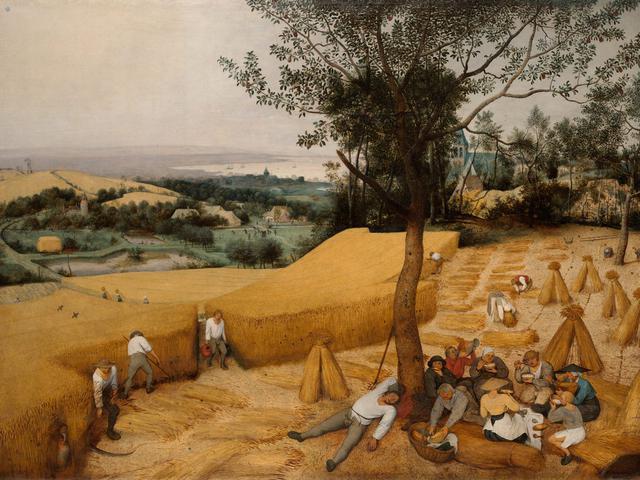The harvesters

The Harvesters is one of six panels painted by Pieter Bruegel the Elder for the suburban Antwerp home of the wealthy merchant Niclaes Jongelinck, and this extraordinary work was notable in its time not only for the quality of its depiction but also because it went beyond the stereotyped. Views of the stations that were typical of the time.
This painting represents the late summer harvest in Belgium. Imagine standing on top of the hill in the foreground watching and listening to this 16th century agricultural scene. Against a background of low hills and a valley, you can see more than 40 people in this painting participating in various activities, so the more you look at this painting, the more people you will discover. In the foreground on the right, next to the large pear tree, a group of hungry people are eating and drinking. They are consuming bowls of milk and cereal, pears from the tree, bread and cheese. The person to the left of this group has already fallen asleep with his pants half open. You can see a church tower hidden behind the trees, just to the right of the large tree in the foreground.
The creator of this masterpiece, Pieter Brueghel the Elder, was an innovative Flemish Renaissance painter and printmaker, known for his sweeping landscapes and peasant scenes. He was apprenticed to painter Pieter Croecke van Aelst from his early life, and in 1551, at the age of 26, he was accepted into the Antwerp painters' guild as a master painter.
His nickname was "Peasant Brueghel", as he often donned peasant clothing and attended social gatherings and weddings, to mingle and interact with the locals, and gain information and inspiration for his paintings. He was also the father of two other prominent Flemish painters, Pieter Brueghel the Younger and Jan Brueghel the Elder, although it is believed that they were not taught by their father, as he died when they were young children. As a pioneer in Dutch genre painting, he portrayed social aspects of 16th-century life, many of which were peasant paintings, with a large element of landscape.
© Tourblink